sensor SUZUKI KIZASHI 2010 1.G Owners Manual
[x] Cancel search | Manufacturer: SUZUKI, Model Year: 2010, Model line: KIZASHI, Model: SUZUKI KIZASHI 2010 1.GPages: 388, PDF Size: 4.94 MB
Page 13 of 388

ILLUSTRATED TABLE OF CONTENTS
57L20-03E
INSTRUMENT PANEL1. Front Fog Light Switch (if equipped)(P.2-105)
2. Lighting Control Lever (P.2-100)/ Turn Signal Control Lever (P.2-105)
3. Shift Paddles (if equipped) (P.3-17)
4. Instrument Cluster (P.2-68)
5. Windshield Wiper and Washer Lever (P.2-107)
6. Front Seat Heater Switch (if equipped) (P.2-28)
7. Hazard Warning Switch (P.2-106)
8. ESP
® OFF Switch (P.3-33)
9. Parking Sensor Switch (if equipped) (P.3-26)
10. 2WD/i-AWD (intelligent All Wheel Drive) Switch (if equipped) (P.3-19)
11. Trunk lid unlatch switch (P.2-5)
12. Engine Hood Release Handle (P.5-75)
13. Tilt/Telescoping/Steering Lock Lever (P.2-110)
14. Engine Switch (P.3-2)
15. Universal Serial Bus (USB) Socket (P.5-81)
16. Accessory Socket (P.5-80)/ Cigarette Lighter (if equipped) (P.5-81)
17. Heated Rear Window and Heated Outside Rearview Mirrors Switch
(if equipped) (P.2-111)
57L1F006
1
3
2
4
7
6
14
13
12
11
9 10
17
16
15
8 5
3
6
Page 40 of 388

2-21BEFORE DRIVING
57L20-03E
Auto dimming rearview mirror (if
equipped)With HomeLink
® Wireless Control Sys-
tem
57L21027
You can adjust the auto dimming rearview
mirror by hand so you can see to the rear
of your vehicle in the mirror. This rearview
mirror has a function of automatically
reducing glare from the lights of vehicles
behind you. The function works when the
ignition mode has been changed to “ON”
by pressing the engine switch.
The mirror is always set to the automatic
dimming mode when the engine switch
is in the “ON” mode.
When the “ON” switch (2) is pushed, the
green indicator (1) is lit, indicating that
the mirror is set to the automatic dim-
ming mode. To cancel the automatic
dimming mode, push the “OFF” switch
(3); the indicator (1) then goes out. The auto dimming rearview mirror is
automatically deactivated while the gear-
shift lever is in the “R” position.
57L21028
Without HomeLink
® Wireless Control
System
57L30019
You can adjust the auto dimming rearview
mirror by hand so you can see to the rear
of your vehicle in the mirror. This rearview
mirror has a function of automatically
reducing glare from the lights of vehicles
behind you. The function works when the
ignition mode has been changed to “ON”
by pressing the engine switch.
The mirror is always set to the automatic
dimming mode when the engine switch
is in the “ON” mode.
When the “AUTO” switch (2) is pushed,
the green indicator (1) is lit, indicating
that the mirror is set to the automatic
dimming mode. To cancel the automatic
dimming mode, push the “AUTO” switch
(2); the indicator (1) then goes out.
(2)
(3) (1)
CAUTION
Do not touch or cover the sensor
(4) since this may impair normal
operation of the system. Blocking
glare from the sensor with an
object such as a shade, sticker,
accessory or baggage may also
impair proper operation of the sys-
tem.
Do not hook anything heavy on the
mirror, or the mirror may break
under the weight.
(4)
(4)
(2)
(1)
Seat Belts and Child Restraint Systems: 3
Page 41 of 388
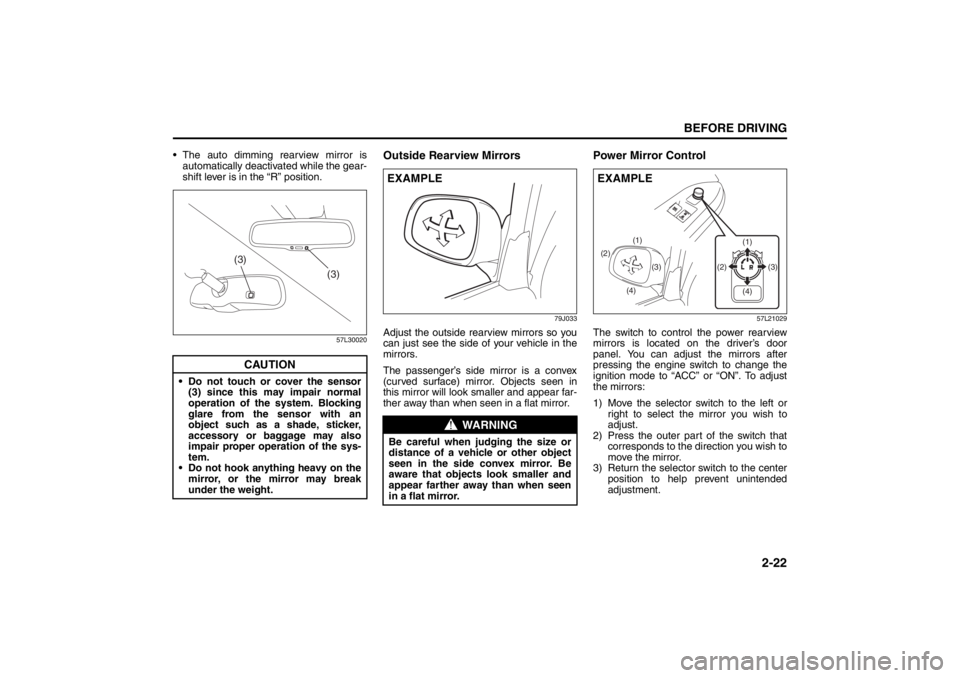
2-22
BEFORE DRIVING
57L20-03E
The auto dimming rearview mirror is
automatically deactivated while the gear-
shift lever is in the “R” position.
57L30020
Outside Rearview Mirrors
79J033
Adjust the outside rearview mirrors so you
can just see the side of your vehicle in the
mirrors.
The passenger’s side mirror is a convex
(curved surface) mirror. Objects seen in
this mirror will look smaller and appear far-
ther away than when seen in a flat mirror.
Power Mirror Control
57L21029
The switch to control the power rearview
mirrors is located on the driver’s door
panel. You can adjust the mirrors after
pressing the engine switch to change the
ignition mode to “ACC” or “ON”. To adjust
the mirrors:
1) Move the selector switch to the left or
right to select the mirror you wish to
adjust.
2) Press the outer part of the switch that
corresponds to the direction you wish to
move the mirror.
3) Return the selector switch to the center
position to help prevent unintended
adjustment.
CAUTION
Do not touch or cover the sensor
(3) since this may impair normal
operation of the system. Blocking
glare from the sensor with an
object such as a shade, sticker,
accessory or baggage may also
impair proper operation of the sys-
tem.
Do not hook anything heavy on the
mirror, or the mirror may break
under the weight.
(3)
(3)
WARNING
Be careful when judging the size or
distance of a vehicle or other object
seen in the side convex mirror. Be
aware that objects look smaller and
appear farther away than when seen
in a flat mirror.EXAMPLE
(2)
(4)(3) (1)
(1)
(3) (2)
(4)
EXAMPLE
Seat Belts and Child Restraint Systems: 3
Page 73 of 388
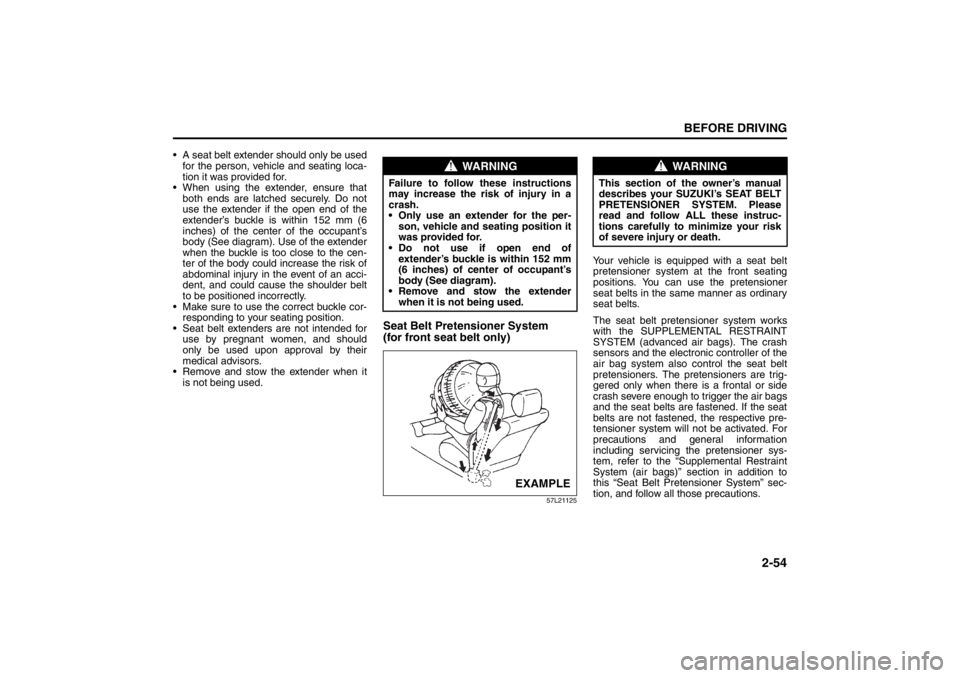
2-54
BEFORE DRIVING
57L20-03E
A seat belt extender should only be used
for the person, vehicle and seating loca-
tion it was provided for.
When using the extender, ensure that
both ends are latched securely. Do not
use the extender if the open end of the
extender’s buckle is within 152 mm (6
inches) of the center of the occupant’s
body (See diagram). Use of the extender
when the buckle is too close to the cen-
ter of the body could increase the risk of
abdominal injury in the event of an acci-
dent, and could cause the shoulder belt
to be positioned incorrectly.
Make sure to use the correct buckle cor-
responding to your seating position.
Seat belt extenders are not intended for
use by pregnant women, and should
only be used upon approval by their
medical advisors.
Remove and stow the extender when it
is not being used.
Seat Belt Pretensioner System
(for front seat belt only)
57L21125
Your vehicle is equipped with a seat belt
pretensioner system at the front seating
positions. You can use the pretensioner
seat belts in the same manner as ordinary
seat belts.
The seat belt pretensioner system works
with the SUPPLEMENTAL RESTRAINT
SYSTEM (advanced air bags). The crash
sensors and the electronic controller of the
air bag system also control the seat belt
pretensioners. The pretensioners are trig-
gered only when there is a frontal or side
crash severe enough to trigger the air bags
and the seat belts are fastened. If the seat
belts are not fastened, the respective pre-
tensioner system will not be activated. For
precautions and general information
including servicing the pretensioner sys-
tem, refer to the “Supplemental Restraint
System (air bags)” section in addition to
this “Seat Belt Pretensioner System” sec-
tion, and follow all those precautions.
WARNING
Failure to follow these instructions
may increase the risk of injury in a
crash.
Only use an extender for the per-
son, vehicle and seating position it
was provided for.
Do not use if open end of
extender’s buckle is within 152 mm
(6 inches) of center of occupant’s
body (See diagram).
Remove and stow the extender
when it is not being used.
EXAMPLE
WARNING
This section of the owner’s manual
describes your SUZUKI’s SEAT BELT
PRETENSIONER SYSTEM. Please
read and follow ALL these instruc-
tions carefully to minimize your risk
of severe injury or death.
Page 75 of 388

2-56
BEFORE DRIVING
57L20-03E
57L21050
17210
9
3
4
12
1213
4
3 9 11 8
811
6
5
15
EXAMPLE
57L21051
Your vehicle is equipped with a Supple-
mental Restraint System consisting of the
following components in addition to a lap-
shoulder belt at each front seating position.
1. Driver’s front air bag
2. Front passenger’s front air bag
3. Seat belt pretensioners
4. Lap outer pretensioners
5. Air bag controller
6. Occupant classification module
7. “PASS AIR BAG OFF” indicator
8. Forward crash sensors
9. Front side air bags
10.Side curtain air bags
11.Side crash sensors
12.Rear side air bags
13.Rear side crash sensors
14.Front passenger’s sensor mat
15.Seat belt buckle sensors
14
Page 80 of 388
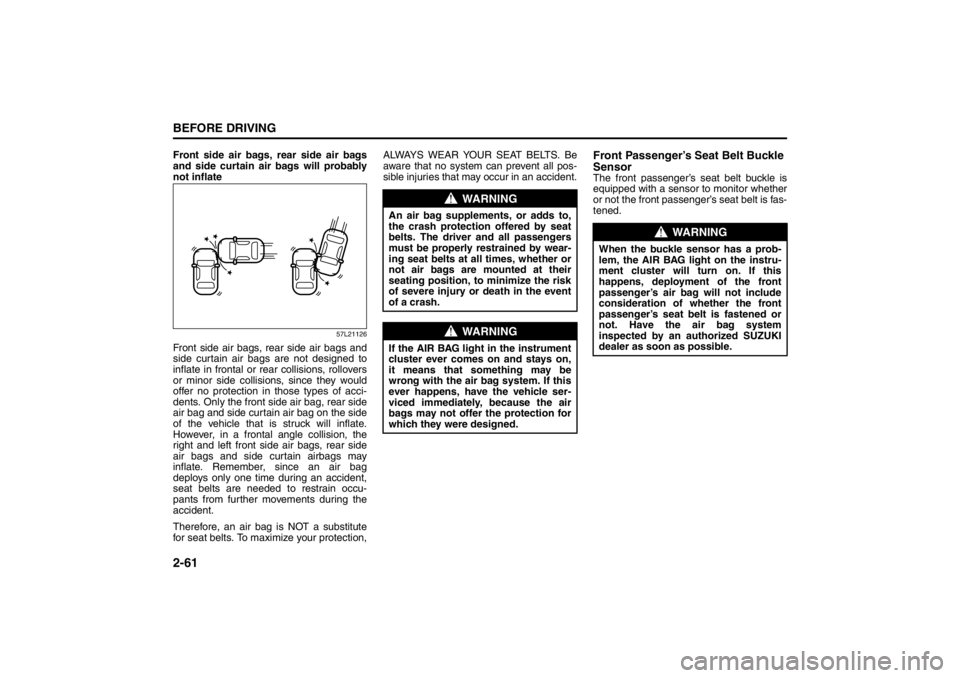
2-61BEFORE DRIVING
57L20-03E
Front side air bags, rear side air bags
and side curtain air bags will probably
not inflate
57L21126
Front side air bags, rear side air bags and
side curtain air bags are not designed to
inflate in frontal or rear collisions, rollovers
or minor side collisions, since they would
offer no protection in those types of acci-
dents. Only the front side air bag, rear side
air bag and side curtain air bag on the side
of the vehicle that is struck will inflate.
However, in a frontal angle collision, the
right and left front side air bags, rear side
air bags and side curtain airbags may
inflate. Remember, since an air bag
deploys only one time during an accident,
seat belts are needed to restrain occu-
pants from further movements during the
accident.
Therefore, an air bag is NOT a substitute
for seat belts. To maximize your protection,ALWAYS WEAR YOUR SEAT BELTS. Be
aware that no system can prevent all pos-
sible injuries that may occur in an accident.
Front Passenger’s Seat Belt Buckle
SensorThe front passenger’s seat belt buckle is
equipped with a sensor to monitor whether
or not the front passenger’s seat belt is fas-
tened.
WARNING
An air bag supplements, or adds to,
the crash protection offered by seat
belts. The driver and all passengers
must be properly restrained by wear-
ing seat belts at all times, whether or
not air bags are mounted at their
seating position, to minimize the risk
of severe injury or death in the event
of a crash.
WARNING
If the AIR BAG light in the instrument
cluster ever comes on and stays on,
it means that something may be
wrong with the air bag system. If this
ever happens, have the vehicle ser-
viced immediately, because the air
bags may not offer the protection for
which they were designed.
WARNING
When the buckle sensor has a prob-
lem, the AIR BAG light on the instru-
ment cluster will turn on. If this
happens, deployment of the front
passenger’s air bag will not include
consideration of whether the front
passenger’s seat belt is fastened or
not. Have the air bag system
inspected by an authorized SUZUKI
dealer as soon as possible.
Page 82 of 388
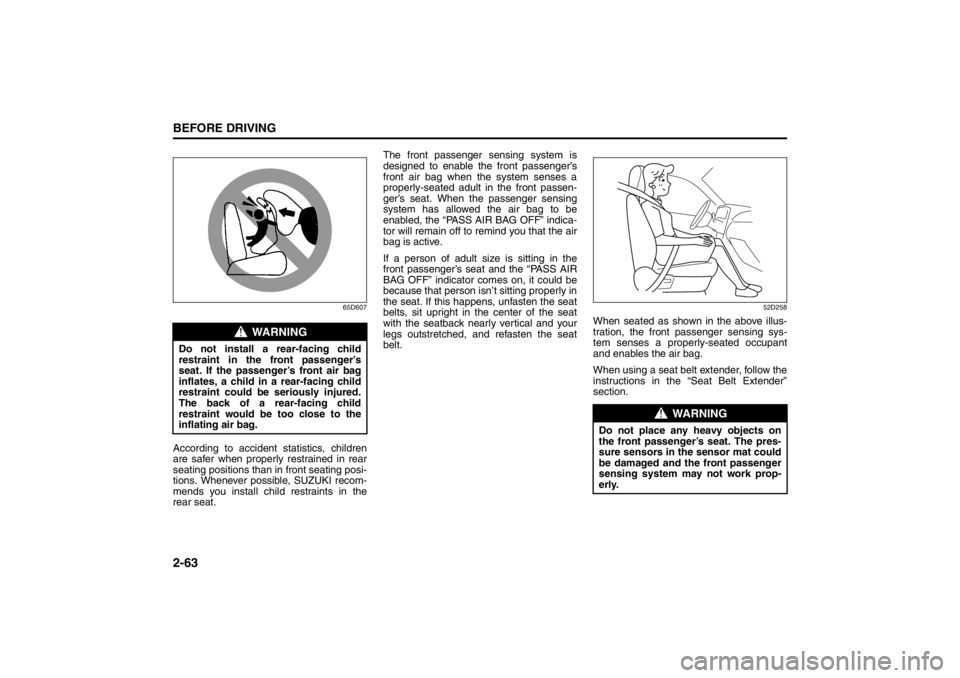
2-63BEFORE DRIVING
57L20-03E
65D607
According to accident statistics, children
are safer when properly restrained in rear
seating positions than in front seating posi-
tions. Whenever possible, SUZUKI recom-
mends you install child restraints in the
rear seat.The front passenger sensing system is
designed to enable the front passenger’s
front air bag when the system senses a
properly-seated adult in the front passen-
ger’s seat. When the passenger sensing
system has allowed the air bag to be
enabled, the “PASS AIR BAG OFF” indica-
tor will remain off to remind you that the air
bag is active.
If a person of adult size is sitting in the
front passenger’s seat and the “PASS AIR
BAG OFF” indicator comes on, it could be
because that person isn’t sitting properly in
the seat. If this happens, unfasten the seat
belts, sit upright in the center of the seat
with the seatback nearly vertical and your
legs outstretched, and refasten the seat
belt.
52D258
When seated as shown in the above illus-
tration, the front passenger sensing sys-
tem senses a properly-seated occupant
and enables the air bag.
When using a seat belt extender, follow the
instructions in the “Seat Belt Extender”
section.
WARNING
Do not install a rear-facing child
restraint in the front passenger’s
seat. If the passenger’s front air bag
inflates, a child in a rear-facing child
restraint could be seriously injured.
The back of a rear-facing child
restraint would be too close to the
inflating air bag.
WARNING
Do not place any heavy objects on
the front passenger’s seat. The pres-
sure sensors in the sensor mat could
be damaged and the front passenger
sensing system may not work prop-
erly.
Page 83 of 388
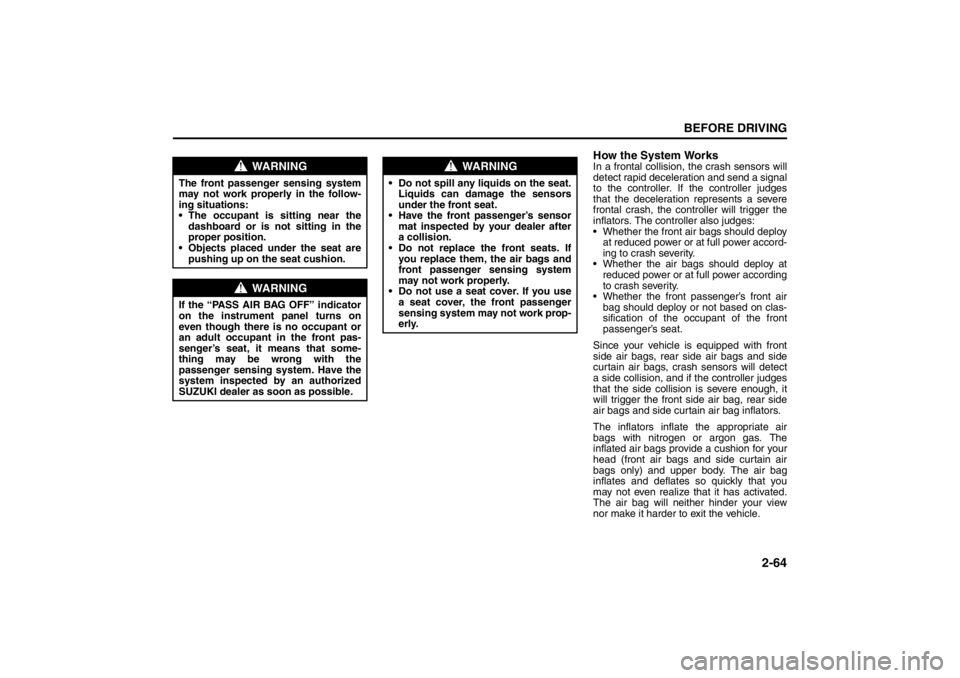
2-64
BEFORE DRIVING
57L20-03E
How the System WorksIn a frontal collision, the crash sensors will
detect rapid deceleration and send a signal
to the controller. If the controller judges
that the deceleration represents a severe
frontal crash, the controller will trigger the
inflators. The controller also judges:
Whether the front air bags should deploy
at reduced power or at full power accord-
ing to crash severity.
Whether the air bags should deploy at
reduced power or at full power according
to crash severity.
Whether the front passenger’s front air
bag should deploy or not based on clas-
sification of the occupant of the front
passenger’s seat.
Since your vehicle is equipped with front
side air bags, rear side air bags and side
curtain air bags, crash sensors will detect
a side collision, and if the controller judges
that the side collision is severe enough, it
will trigger the front side air bag, rear side
air bags and side curtain air bag inflators.
The inflators inflate the appropriate air
bags with nitrogen or argon gas. The
inflated air bags provide a cushion for your
head (front air bags and side curtain air
bags only) and upper body. The air bag
inflates and deflates so quickly that you
may not even realize that it has activated.
The air bag will neither hinder your view
nor make it harder to exit the vehicle.
WARNING
The front passenger sensing system
may not work properly in the follow-
ing situations:
The occupant is sitting near the
dashboard or is not sitting in the
proper position.
Objects placed under the seat are
pushing up on the seat cushion.
WARNING
If the “PASS AIR BAG OFF” indicator
on the instrument panel turns on
even though there is no occupant or
an adult occupant in the front pas-
senger’s seat, it means that some-
thing may be wrong with the
passenger sensing system. Have the
system inspected by an authorized
SUZUKI dealer as soon as possible.
WARNING
Do not spill any liquids on the seat.
Liquids can damage the sensors
under the front seat.
Have the front passenger’s sensor
mat inspected by your dealer after
a collision.
Do not replace the front seats. If
you replace them, the air bags and
front passenger sensing system
may not work properly.
Do not use a seat cover. If you use
a seat cover, the front passenger
sensing system may not work prop-
erly.
Page 85 of 388

2-66
BEFORE DRIVING
57L20-03E
Note that even though your vehicle may be
moderately damaged in a collision, the col-
lision may not have been severe enough to
trigger the front, side, rear side, or side
curtain air bags to inflate. If your car sus-
tains ANY front-end or side damage, have
the air bag system inspected by an autho-
rized SUZUKI dealer to ensure it is in
proper working order.
Your vehicle is equipped with a diagnostic
module which records information about
the air bag system if the air bags deploy in
a crash. The module records information
about overall system status, which sensors
activated the deployment, and whether the
front seat belts were in use.
Servicing the Air Bag SystemIf the air bags inflate, have the air bags and
related components replaced by an autho-
rized SUZUKI dealer as soon as possible.
If your vehicle ever gets in deep water and
the driver’s floor is submerged, the air bag
controller could be damaged. If this hap-
pens, have the air bag system inspected
by the SUZUKI dealer as soon as possible.
Special procedures are required for servic-
ing or replacing an air bag. For that reason,
only an authorized SUZUKI dealer should
be allowed to service or replace your air
bags. Please remind anyone who services
your SUZUKI that it has air bags.
Service on or around air bag components
or wiring must be performed only by an
authorized SUZUKI dealer. Improper ser-
vice could result in unintended air bag
deployment or could render the air bags
inoperative. Either of these two conditions
may result in severe injury.To prevent damage or unintended inflation
of the air bag system, be sure the battery
is disconnected and the engine switch has
been in the “LOCK” (OFF) mode for at
least 90 seconds before performing any
electrical service work on your SUZUKI.
Do not touch air bag system components
or wires. The wires are wrapped with yel-
low tape or yellow tubing, and the couplers
are yellow for easy identification.
Scrapping a car that has an undeployed air
bag can be hazardous. Ask your dealer,
body repair shop or scrap yard for help
with disposal.
Page 92 of 388
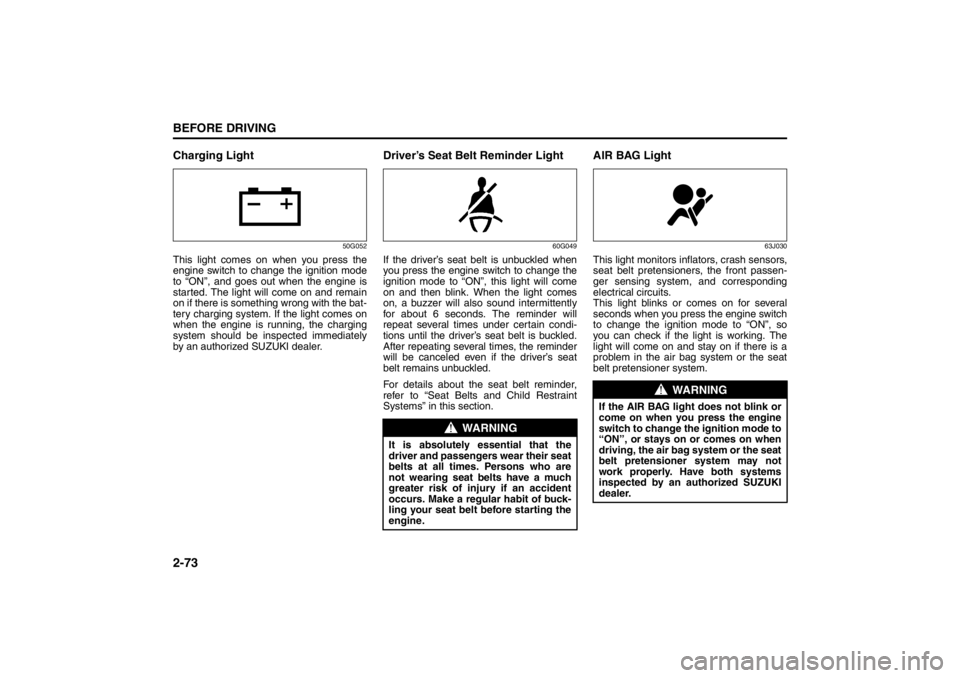
2-73BEFORE DRIVING
57L20-03E
Charging Light
50G052
This light comes on when you press the
engine switch to change the ignition mode
to “ON”, and goes out when the engine is
started. The light will come on and remain
on if there is something wrong with the bat-
tery charging system. If the light comes on
when the engine is running, the charging
system should be inspected immediately
by an authorized SUZUKI dealer.
Driver’s Seat Belt Reminder Light
60G049
If the driver’s seat belt is unbuckled when
you press the engine switch to change the
ignition mode to “ON”, this light will come
on and then blink. When the light comes
on, a buzzer will also sound intermittently
for about 6 seconds. The reminder will
repeat several times under certain condi-
tions until the driver’s seat belt is buckled.
After repeating several times, the reminder
will be canceled even if the driver’s seat
belt remains unbuckled.
For details about the seat belt reminder,
refer to “Seat Belts and Child Restraint
Systems” in this section.
AIR BAG Light
63J030
This light monitors inflators, crash sensors,
seat belt pretensioners, the front passen-
ger sensing system, and corresponding
electrical circuits.
This light blinks or comes on for several
seconds when you press the engine switch
to change the ignition mode to “ON”, so
you can check if the light is working. The
light will come on and stay on if there is a
problem in the air bag system or the seat
belt pretensioner system.
WARNING
It is absolutely essential that the
driver and passengers wear their seat
belts at all times. Persons who are
not wearing seat belts have a much
greater risk of injury if an accident
occurs. Make a regular habit of buck-
ling your seat belt before starting the
engine.
WARNING
If the AIR BAG light does not blink or
come on when you press the engine
switch to change the ignition mode to
“ON”, or stays on or comes on when
driving, the air bag system or the seat
belt pretensioner system may not
work properly. Have both systems
inspected by an authorized SUZUKI
dealer.